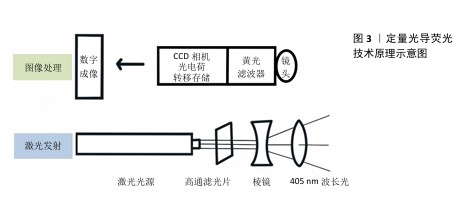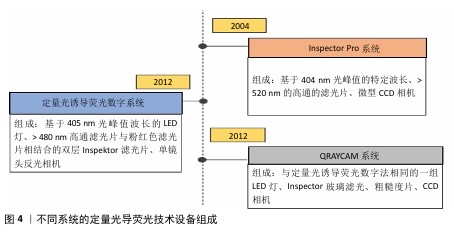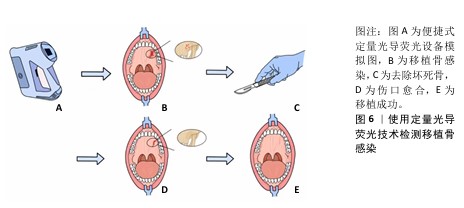[1] 王守涛,陈庆光,林斌,等.光学技术在早期龋齿检测中的应用[J].激光生物学报,2009,18(6):846-852.
[2] 杜亚鑫.定量光激发荧光技术在龋病诊断中的应用研究进展[J].口腔医学,2022, 42(11):1052-1056.
[3] DE JOSSELIN DE JONG E, SUNDSTRÖM F, WESTERLING H, et al. A new method for in vivo quantification of changes in initial enamel caries with laser fluorescence. Caries Res. 1995;29(1):2-7.
[4] SILVA FG, FREITAS PM, MENDES FM, et al. Monitoring enamel caries on resin-treated occlusal surfaces using quantitative light-induced fluorescence: an in vitro study. Lasers Med Sci. 2020;35(7):1629-1636.
[5] 李新尚,赵今.定量光敏荧光技术用于釉质脱矿与再矿化的研究进展[J].重庆医学,2010,39(24):3435-3437.
[6] 陈艳艳,彭显,周学东,等.定量光导荧光技术在龋病及牙周疾病诊治中的应用[J].国际口腔医学杂志,2019,46(6):699-704.
[7] 胡德渝,冯岩,尹伟,等.龋病早期诊断方法的进展及评价[J].实用医院临床杂志,2007,4(2):19-21.
[8] OH SH, LEE SR, CHOI JY, et al. Detection of Dental Caries and Cracks with Quantitative Light-Induced Fluorescence in Comparison to Radiographic and Visual Examination: A Retrospective Case Study. Sensors (Basel). 2021;21(5):1741.
[9] KEALLEY C, ELCOMBE M, VANRIESSEN A, et al. Development of carbon nanotube-reinforced hydroxyapatite bioceramics. Physica B: Condensed Matter. 2006: 385-386:496-498.
[10] PARK SW, KIM SK, LEE HS, et al. Comparison of fluorescence parameters between three generations of QLF devices for detecting enamel caries in vitro and on smooth surfaces. Photodiagnosis Photodyn Ther. 2019;25:142-147.
[11] PARK EY, JEONG S, KANG S, et al. Tooth caries classification with quantitative light-induced fluorescence (QLF) images using convolutional neural network for permanent teeth in vivo. BMC Oral Health. 2023;23(1):981.
[12] 郭欣欣,李涛.早期龋病防治方法的应用研究进展[J].山东医药,2023,63(30): 111-115.
[13] LEE JW, LEE ES, KIM BI. Optical diagnosis of dentin caries lesions using quantitative light-induced fluorescence technology. Photodiagnosis Photodyn Ther. 2018;23: 68-70.
[14] LITZENBURGER F, SCHÄFER G, HICKEL R, et al. Comparison of novel and established caries diagnostic methods: a clinical study on occlusal surfaces. BMC Oral Health. 2021;21(1):97.
[15] CHO KH, KANG CM, JUNG HI, et al. The diagnostic efficacy of quantitative light-induced fluorescence in detection of dental caries of primary teeth. J Dent. 2021; 115:103845.
[16] JALLAD M, ZERO D, ECKERT G, et al. In vitro Detection of Occlusal Caries on Permanent Teeth by a Visual, Light-Induced Fluorescence and Photothermal Radiometry and Modulated Luminescence Methods. Caries Res. 2015;49(5):523-530.
[17] FELIX GG, ECKERT GJ, FERREIRA ZA. Orange/Red Fluorescence of Active Caries by Retrospective Quantitative Light-Induced Fluorescence Image Analysis. Caries Res. 2016;50(3):295-302.
[18] KO HY, KANG SM, KIM HE, et al. Validation of quantitative light-induced fluorescence-digital (QLF-D) for the detection of approximal caries in vitro. J Dent. 2015; 43(5):568-575.
[19] KIM ES, LEE ES, KANG SM, et al. A new screening method to detect proximal dental caries using fluorescence imaging. Photodiagnosis Photodyn Ther. 2017;20: 257-262.
[20] SHANKARAPPA S, BURK JT, SUBBAIAH P,
et al. White spot lesions in fixed orthodontic treatment: Etiology, pathophysiology, diagnosis, treatment, and future research perspectives. J Orthod Sci. 2024;13:21.
[21] BOERSMA JG, VANDERVEEN MH, LAGERWEIJ MD, et al. Caries prevalence measured with QLF after treatment with fixed orthodontic appliances: influencing factors. Caries Res. 2005;39(1):41-47.
[22] KANG SM, JEONG SH, KIM HE, et al. Photodiagnosis of White Spot Lesions after Orthodontic Treatment with a Quantitative Light-induced Fluorescence-Digital System: A Pilot Study. Oral Health Prev Dent. 2017; 15(5):483-488.
[23] MILLER CC, BURNSIDE G, HIGHAM SM, et al.
Quantitative Light-induced Fluorescence-Digital as an oral hygiene evaluation tool to assess plaque accumulation and enamel demineralization in orthodontics. Angle Orthod. 2016;86(6):991-997.
[24] PARK SW, KANG SM, LEE HS, et al. Lesion activity assessment of early caries using dye-enhanced quantitative light-induced fluorescence. Sci Rep. 2022;12(1):11848.
[25] TATANO R, BERKELS B, EHRLICH EE, et al.
Spatial agreement of demineralized areas in quantitative light-induced fluorescence images and digital photographs. Dentomaxillofac Radiol. 2018;47(8):20180099.
[26] GOMEZ J. Detection and diagnosis of the early caries lesion. BMC Oral Health. 2015;15 Suppl 1(Suppl 1):S3.
[27] 朱瑞文,张道楔.颌骨骨髓炎的诊断与治疗[J].中级医刊,1958(3):31-32.
[28] BRONKHORST MA, VANDAMME PA. Osteomyelitis of the jaws. Ned Tijdschr Tandheelkd. 2006;113(6):222-225.
[29] 刘向东.30例颌骨骨髓炎临床分析[J].中国中西医结合耳鼻咽喉科杂志,2022, 30(4):283-285.
[30] KIM Y, KU JK. Quantitative light-induced fluorescence-guided surgery for medication-related osteomyelitis of the jaw. Photodiagnosis Photodyn Ther. 2024;45:103867.
[31] KIM Y, JUNG HI, KIM YK, et al. Histologic analysis of osteonecrosis of the jaw according to the different aspects on quantitative light-induced fluorescence images. Photodiagnosis Photodyn Ther. 2021;34:102212.
[32] KU JK, KIM JY, KIM BI, et al. Evaluation of wound dehiscence after vertical bone graft by using quantitative light-induced fluorescence. Photodiagnosis Photodyn Ther. 2021;36:102470.
[33] BERNARDI S, KARYGIANNI L, FILIPPI A, et al. Combining culture and culture-independent methods reveals new microbial composition of halitosis patients’ tongue biofilm. Microbiologyopen. 2020;9(2):e958.
[34] MOGILNICKA I, BOGUCKI P, UFNAL M. Microbiota and Malodor-Etiology and Management. Int J Mol Sci. 2020; 21(8):2886.
[35] KRESPI YP, KIZHNER V, WILSON KA, et al.
Laser tongue debridement for oral malodor-A novel approach to halitosis. Am J Otolaryngol. 2021;42(1):102458.
[36] LEE ES, DE JOSSELIN DJE, KIM BI. Detection of dental plaque and its potential pathogenicity using quantitative light-induced fluorescence. J Biophotonics. 2019;12(7): e201800414.
[37] LEE ES, YIM HK, LEE HS, et al. Clinical assessment of oral malodor using autofluorescence of tongue coating. Photodiagnosis Photodyn Ther. 2016;13: 323-329.
[38] LEE ES, YIM HK, LEE HS, et al. Plaque autofluorescence as potential diagnostic targets for oral malodor. J Biomed Opt. 2016;21(8):85005.
[39] KIM YR, KANG HK. Analysis of Quantitative Light-Induced Fluorescence Images for the Assessment of Bacterial Activity and Distribution of Tongue Coating. Healthcare (Basel). 2023;11(2):217.
[40] BICAK DA. A Current Approach to Halitosis and Oral Malodor- A Mini Review. Open Dent J. 2018;12:322-330.
[41] CAMERON CE. Cracked tooth syndrome. J Am Dent Assoc. 1964;68:405-411.
[42] HASAN S, SINGH K, SALATI N. Cracked tooth syndrome: Overview of literature. Int J Appl Basic Med Res. 2015;5(3):164-168.
[43] BERMAN LH, KUTTLER S. Fracture necrosis: diagnosis, prognosis assessment, and treatment recommendations. J Endod. 2010;36(3):442-446.
[44] EHRMANN EH, TYAS MJ. Cracked tooth syndrome: diagnosis, treatment and correlation between symptoms and post-extraction findings. Aust Dent J. 1990; 35(2):105-112.
[45] IMAI K, SHIMADA Y, SADR A, et al. Noninvasive cross-sectional visualization of enamel cracks by optical coherence tomography in vitro. J Endod. 2012;38(9): 1269-1274.
[46] KALYAN CP, TELANG LA, NERALI J, et al. Cracked tooth: a report of two cases and role of cone beam computed tomography in diagnosis[. Case Rep Dent. 2012;525364.
[47] LYNCH CD, MCCONNELL RJ. The cracked tooth syndrome. J Can Dent Assoc. 2002; 68(8):470-475.
[48] SADASIVA K, RAMALINGAM S, RAJARAM K, et al. Cracked tooth syndrome: A report of three cases. J Pharm Bioallied Sci. 2015; 7(Suppl 2):S700-S703.
[49] WANG P, YAN XB, LUI DG, et al. Detection of dental root fractures by using cone-beam computed tomography. Dentomaxillofac Radiol. 2011;40(5):290-298.
[50] JUN MK, KU HM, KIM E, et al. Detection and Analysis of Enamel Cracks by Quantitative Light-induced Fluorescence Technology. J Endod. 2016;42(3):500-504.
[51] RICUCCI D, SIQUEIRA JJ, LOGHIN S, et al.
The cracked tooth: histopathologic and histobacteriologic aspects. J Endod. 2015; 41(3):343-352.
[52] LEE JI, JEON MJ, DE JONG EJ, et al. Evaluation of the clinical efficacy of quantitative light-induced fluorescence technology in diagnosing cracked teeth. Photodiagnosis Photodyn Ther. 2023;41:103299.
[53] SON SA, KIM JH, PARK JK. Clinical applications of a quantitative light-induced fluorescent (QLF) device in the detection and management of cracked teeth: A case repor. Photodiagnosis Photodyn Ther. 2023; 43:103735.
[54] 赵亚鹏,牛一山.牙齿磨损的研究现状[J].内蒙古医科大学学报,2016, 38(3): 268-272.
[55] KIM SK, LEE HS, PARK SW, et al. Quantitative light-induced fluorescence technology for quantitative evaluation of tooth wear. J Biomed Opt. 2017;22(12):1-6.
[56] KIM SK, JUNG HI, KIM BI. Detection of dentin-exposed occlusal/incisal tooth wear using quantitative light-induced fluorescence technology. J Dent. 2020;103: 103505.
[57] SHIMADA Y, YOSHIYAMA M, TAGAMI J, et al.
Evaluation of dental caries, tooth crack, and age-related changes in tooth structure using optical coherence tomography. Jpn Dent Sci Rev. 2020;56(1):109-118.
[58] WADA I, SHIMADA Y, IKEDA M, et al. Clinical assessment of non carious cervical lesion using swept-source optical coherence tomography. J Biophotonics. 2015;8(10):846-854.
[59] ALGHILAN MA, LIPPERT F, PLATT JA, et al. In vitro longitudinal evaluation of enamel wear by cross-polarization optical coherence tomography. Dent Mater. 2019;35(10): 1464-1470.
[60] NAM SM, KU HM, LEE ES, et al. Detection of pit and fissure sealant microleakage using quantitative light-induced fluorescence technology: an in vitro study. Sci Rep. 2024; 14(1):9066.
|





